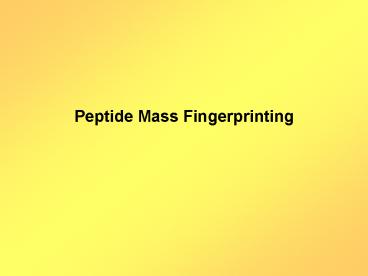Peptide Mass Fingerprinting - PowerPoint PPT Presentation
1 / 30
Title:
Peptide Mass Fingerprinting
Description:
Identifying proteins using mass spectrometry. Peptide Specific protein fragment ... Peptide masses in Da: http://us.expasy.org/tools/peptide-mass.html ... – PowerPoint PPT presentation
Number of Views:1826
Avg rating:5.0/5.0
Title: Peptide Mass Fingerprinting
1
Peptide Mass Fingerprinting
2
Peptide Mass Fingerprinting
Identifying proteins using mass spectrometry
Peptide Specific protein fragment ...usually
generated with trypsin Mass the size of the
peptide Fingerprint - Uniqueness
800, 900, 1500
700, 1000, 1600
3
Peptide Mass Fingerprinting
Pick proteins
Digest
Spot on Target
2D Gel
Collect mass data
Search databases
4
Peptide Mass Fingerprinting
- Digest with specific protease
- Clean up sample (remove salts)
- Spot to MALDI target
- Collect spectra
- Interpret spectra
- Database search
5
Digest with specific protease
Trypsin (K, R not followed by P) Chymotrypsin
(F, W, Y, L, M) Lys-C (K) Arg-C (R) Asp-N (D,
N-terminal) V8-bicarb (E) V8-biphosph (E,
D) CNBr (M)
6
Digest with specific protease
Why trypsin?
7
Digest with specific protease
546 aa 60 kDa 57 461 Da pI 4.75
gtRBME00320 Contig0311_1089618_1091255 EC-mopA 60
KDa chaperonin GroEL MAAKDVKFGR TAREKMLRGV
DILADAVKVT LGPKGRNVVI EKSFGAPRIT KDGVSVAKEV
ELEDKFENMG AQMLREVASK TNDTAGDGTT TATVLGQAIV
QEGAKAVAAG MNPMDLKRGI DLAVNEVVAE LLKKAKKINT
SEEVAQVGTI SANGEAEIGK MIAEAMQKVG NEGVITVEEA
KTAETELEVV EGMQFDRGYL SPYFVTNPEK MVADLEDAYI
LLHEKKLSNL QALLPVLEAV VQTSKPLLII AEDVEGEALA
TLVVNKLRGG LKIAAVKAPG FGDCRKAMLE DIAILTGGQV
ISEDLGIKLE SVTLDMLGRA KKVSISKENT TIVDGAGQKA
EIDARVGQIK QQIEETTSDY DREKLQERLA KLAGGVAVIR
VGGATEVEVK EKKDRVDDAL NATRAAVEEG IVAGGGTALL
RASTKITAKG VNADQEAGIN IVRRAIQAPA RQITTNAGEE
ASVIVGKILE NTSETFGYNT ANGEYGDLIS LGIVDPVKVV
RTALQNAASV AGLLITTEAM IAELPKKDAA PAGMPGGMGG
MGGMDF
8
Digest with specific protease
Trypsin yields 47 peptides (theoretically)
Peptide masses in Da
501.3 533.3 544.3 545.3 614.4 634.3 674.3 675.4
701.4 726.4 822.4 855.5 861.4 879.4 921.5 953.4
974.5 988.5 1000.6 1196.6 1217.6 1228.5 1232.6 1
233.7 1249.6 1249.6 1344.7 1455.8 1484.6 1514.8
1582.9 1583.9 1616.8 1726.7 1759.9 1775.9 1790
.6 1853.9 1869.9 2286.2 2302.2 2317.2 2419.2 252
6.4 2542.4 3329.6 4211.4
http//us.expasy.org/tools/peptide-mass.html
9
Digest with specific protease
Trypsin yields 47 peptides (theoretically)
Peptide masses in Da
501.3 533.3 544.3 545.3 614.4 634.3 674.3 675.4
701.4 726.4 822.4 855.5 861.4 879.4 921.5 953.4
974.5 988.5 1000.6 1196.6 1217.6 1228.5 1232.6 1
233.7 1249.6 1249.6 1344.7 1455.8 1484.6 1514.8
1582.9 1583.9 1616.8 1726.7 1759.9 1775.9 1790
.6 1853.9 1869.9 2286.2 2302.2 2317.2 2419.2 252
6.4 2542.4 3329.6 4211.4
http//us.expasy.org/tools/peptide-mass.html
10
Digest with specific protease
Trypsin yields 47 peptides (theoretically)
In practice.......see far fewer by mass spec -
possibly incomplete digest (we allow 1 miss) -
lose peptides during each manipulation washes
during digestion washes during cleanup
step some peptides will not ionize well some
signals (peaks) are poor low intensity lack
resolution
11
Digest with specific protease
Summary of digestion protocol
1. Wash gel plugs (in water from picking) wash
into 50 mM ABC, pH 7.9 2. Reduce disulfide bonds
with DTT (dithiothreitol) 3. Alkylate with IAA
(iodoacetamide) yields carbamidomethylated
cysteines 4. Digest with trypsin (7.5 h at 37
C) 5. Modify with O-methylisourea
(guanidination)
Ensures more "homogenous" samples
12
Digest with specific protease
Why O-methylisourea?
Converts lysines to homoarginines homoargini
ne ionizes better than lysine a second way to
evaluate search results
http//www.biochimie.univ-montp2.fr/licence/qabs /
peptides/residus/ac_amine_lys_isor.gif
13
Clean up sample (remove salts)
Why ?
Salts interfere with ionization in MALDI
How ?
Bind acidified peptides to C18 resin (hydrophobic
interaction) peptides contained in 10 formic
acid C18 resin conditioned with 50 ACN in
water Salts washed away with water
14
Spot to MALDI target
How ?
Elute peptides from C18 resin in matrix
solution matrix solution saturated with
a-cyano-4-hydroxycinnamic acid 50 ACN, 1 TFA
in water Bonus Peptides eluted from tip
in top-down manner..... ......concentrates our
peptides in 1 µL!
Target stainless steel voltage applied 20 kV
DC
15
Collect Spectra
physical characteristics exploited...
Mass not weight larger particles fly
slower Charge the greater the charge, the
faster the particle Time Particles of
particular mass and charge reach the detector
at particular times
16
Collect Spectra
essential parts of mass spectrometer...
Source promote ionization of sample Field
electric or magnetic Flight tube - must be under
vacuum, i.e. the absence of
molecules in the atmosphere Detector - early
ones were fluorescent screens or films
currently are photomultiplier
tubes Timing device - highly sensitive
measures on the order of ns
17
Collect spectra
Axima CFR Schematic...
Axima CFR from Kratos Curved Field
Reflectron MALDI Matrix Assisted Laser
Desorption Ionization
18
Collect spectra
Ionization
Need to create charge on your sample! Usually
always 1 for MALDI. Exact mechanism is still
unknown for MALDI.
19
Interpret Spectra
Calibrate - Trypsin autolysis peaks (not always
well resolved!) Select - Monoisotopic peaks
(first in series isotopically pure) Avoid -
keratin peaks - "ghost" peaks - trypsin
autolysis peaks
20
Interpret Spectra
monoisotopic resolution...
...relative abundance of isotopes in nature
21
Database search
Mascot
theoretical
experimental
Protein ID
22
(No Transcript)
23
Database search
Interpretation of Results
Not 100 identification .statistically most
probable match
- of peptides matched
- (percentage)
- probability by chance
- (more than random)
Does the chemistry make sense? low incidence of
missed cleavage most lysines modified
24
(No Transcript)
25
(No Transcript)
26
(No Transcript)
27
Consistently 2 missed cleavages No modifications
on lysine
28
Database search
pitfalls...
- Improper calibration
- Improper mass tolerance
- - too large or too small
- Number of peptides submitted
- too many / too few
- inclusion of contaminants (keratin, trypsin)
- Consider modifications
- under and over accounting
- Improper MW and pI filters
- - can select portion of database
29
Summary
- Peptide mass fingerprinting provides evidence
- for the most probable identity of a protein.
- All search engines are not the same, even if
- they are searching the same database.
- Obtaining useful information from peptide mass
- fingerprinting requires extreme care.
30
Partial Global Proteome Mapof B. melitensis 16M































